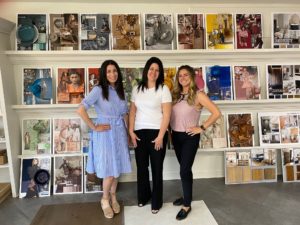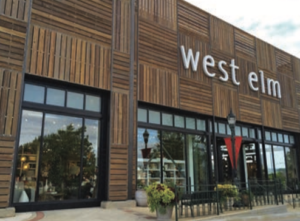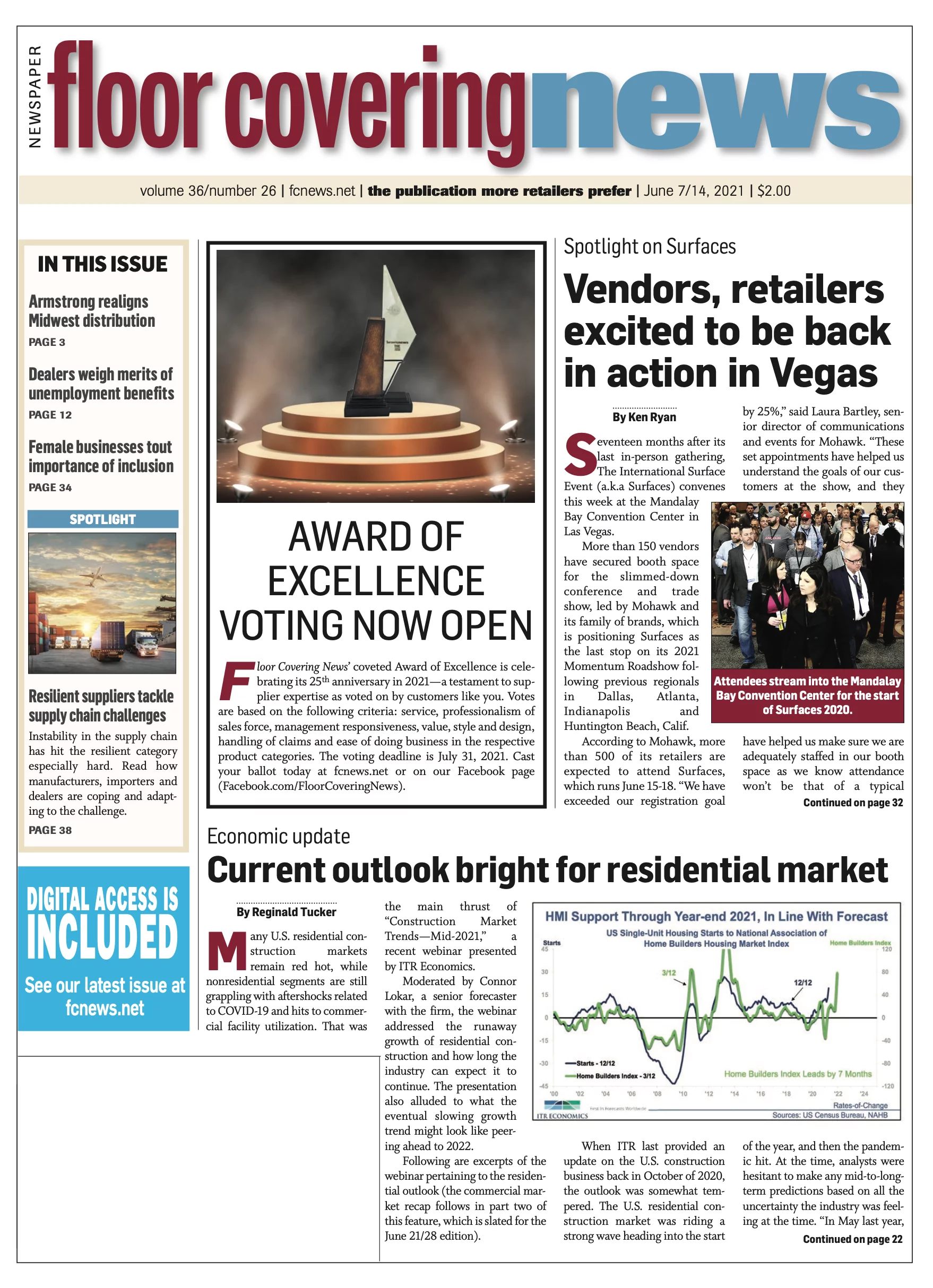Salem, N.J.—Mannington has always enjoyed the reputation of being a leader in styling and design. For decades, industry veterans Stuart Beattie and then Joe Amato led the department. Today, the team is led by Terry Marchetta, who worked alongside both Beattie and Amato until Amato’s retirement a couple of years ago. She and her colleagues Cristen Del Bove and Renee Cannon form one of the strongest design teams in the floor covering industry. The trinity works together to ensure Mannington maintains its styling and design leadership. But it’s nothing they haven’t been doing behind the scenes for years, which ensures continuity. FCNews publisher, Steven Feldman, recently sat down with the three designers to get some perspective.
Terry Marchetta, senior director of residential styling
Marchetta has been with Mannington for 23 years. She attended Philadelphia College of Textiles and Science, where she gained her degree in Textile Design with a concentration in print design. Her first job was in Jacquard design, working on upholstery fabric. She eventually landed at Mannington in 1998, where she started as a designer and moved up the ranks to her current role.
Cristen Del Bove, director of residential styling
Del Bove majored in Fiber Arts at the University of the Arts in Philadelphia, and then received a Masters in Textile Design from the Philadelphia College of Textiles and Science. From there, she designed bedding and kitchen textiles, before joining Mannington 16 years ago. She worked on a variety of product categories before moving into her current role.
Renee Cannon, senior residential stylist
Cannon started at Mannington in 2007 as an intern doing color work for sheet vinyl and commercial carpet. In college, her major was in nursing, but she had a keen eye and talent. After almost a year of freelancing, she applied for a position as junior stylist; she eventually worked toward stylist and is currently senior stylist.
Three designers, three different styles

“I tend to lean more toward traditional design. I find value in quality and use high-end furniture in combination with antiques to create a classic interior look. I’ll change the colors on my walls and my accessories depending on the season, but not necessarily the furniture. Brands that I lean toward center around Thomasville and Ethan Allen as well as one-of-a-kind vintage luxury pieces that feature the fine art of craftsmanship.”

“I’m definitely eclectic. Mid-century modern furniture mixed with artistically unique pieces, with a little Bohemian mixed in. I’m very much into the textiles. I always start with a rug as my design base and then work from there. I would say brands like Restoration Hardware and Anthropologie emulate my style. I like things that don’t look like everyone else has them. I take that same approach with design—something no one else has seen before. Looking at what other people have in their line, what we already have and trying to find something that’s unique but universally appealing.”

“I like classic style with a mix of glam and light rustic accessories. I would consider myself very eclectic; however, my house is very neutral. I know that trends come and go, so I try to select pieces that will last for years to come. It’s the same with flooring. I know it’s a major commitment. So, when I design a floor, I want it to be somewhat classic, so it can create a backdrop to allow the consumer’s style to be featured.”
Collaboration

The Residential design team is on the same page when it comes to design. “I think we communicate very well, which is hard to find in a creative group, mainly because everybody’s opinion is typically diverse,” Marchetta said. “I think we respect each other enough to put our opinions on the table and listen to each other’s comments. Believe me, we are extremely passionate when it comes to product. This team thrives on collaboration and there’s a specific style that comes from it.”
How designs are developed
 It all begins with shopping, according to Del Bove. “We’re looking at home interior design, and what is trending in colors and accessories being used in the home. Through research we need to know what’s trending in flooring— woods, stones—and how the consumer is using these looks in the home.”
It all begins with shopping, according to Del Bove. “We’re looking at home interior design, and what is trending in colors and accessories being used in the home. Through research we need to know what’s trending in flooring— woods, stones—and how the consumer is using these looks in the home.”
Marchetta noted that 95% of their job is research. “We’re almost trend forecasters in a way, because we have to understand what the customer is buying. We have to understand color and the materials the customer is using on the floor. Our collective research puts us in the right direction to create looks the consumer loves.”
While they may have the same direction, that doesn’t mean they have the exact same aesthetics. “For instance, I tend to be inspired by Scandinavian and Bohemian design, whereas Terry tends to like looks that are traditional and focus on refined rustics,” Del Bove explained. “Renee is trendier in her approach, probably because she’s the youngest of us three. But even though we each have slightly different aesthetics, when it comes to what’s actually going to sell, our base research puts us all on the same page. And then we can each put our own little twist on things.”
At the end of the day, it all comes back to relevance. “You have to do what’s now because everything we do has to coordinate with products we see in stores that span the spectrum from high end to mid-range to budget friendly,” Marchetta said. “West Elm, Crate & Barrel, Target, Home Goods—these are places where our customer shops. Our visuals have to be on trend and easily transition with what the consumer is seeing and buying.”
Aside from shopping, it’s also about watching shows on HGTV and scouring Instagram where consumers get their inspiration. “Influencers like Joanna Gaines and the Property Brothers set the tone and are inspiring the consumer,” Cannon said. “We have to make sure that we are relevant, and our floors coordinate with the interior styles that they are showing.”
The impact of COVID-19
“In a way, it was actually a benefit,” Del Bove said. “COVID-19 allowed us to disrupt our timeline, and now we’re designing six to eight months ahead of where we normally would be.”
No spotlight, no pressure
 “The spotlight isn’t really on us, it’s on the products we create. But we are up for the challenges we face each year when tasked with designing new products. Collectively, this styling team has 53 years of styling experience, doing what we love.”
“The spotlight isn’t really on us, it’s on the products we create. But we are up for the challenges we face each year when tasked with designing new products. Collectively, this styling team has 53 years of styling experience, doing what we love.”
 “We have a fire inside us, as designers, to make sure what we produce and launch each year is better than anything we’d ever done before.”
“We have a fire inside us, as designers, to make sure what we produce and launch each year is better than anything we’d ever done before.”
 “It’s always been a team collaboration. Mannington styling has always been a well-oiled machine, no matter who is leading. The foundation to our success is Mannington’s culture—we care, we do the right thing, we work hard and play hard and we control our own destiny. As a result, we all are working toward the same goal of producing great product, which helps everything go more smoothly through the entire process.”
“It’s always been a team collaboration. Mannington styling has always been a well-oiled machine, no matter who is leading. The foundation to our success is Mannington’s culture—we care, we do the right thing, we work hard and play hard and we control our own destiny. As a result, we all are working toward the same goal of producing great product, which helps everything go more smoothly through the entire process.”
Differences between then and now
What’s different today is Mannington has an all-female styling group, “which is interesting because most of the time interior decorating decisions are made by women,” Marchetta said. “So, I think we’re a bit more attuned to the wants and needs of the consumer. And I think it’s more collaborative. We have better communication and have established a forum to share ideas.”
Design challenges
 “You can always think outside the box, but often our visions are constrained by what we can do through manufacturing. You can’t always be 100% creative. There’s always somewhat of a restriction when you have to scale up an idea to mass production.”
“You can always think outside the box, but often our visions are constrained by what we can do through manufacturing. You can’t always be 100% creative. There’s always somewhat of a restriction when you have to scale up an idea to mass production.”
 “For me, the difference between art and design is that design has parameters and rules based on manufacturing. I like rules and parameters because when you can create anything, sometimes you get stuck. But as creatives, when we have those rules and those boundaries, sometimes we want to break them because that’s human nature. We’re constantly trying to push the envelope.”
“For me, the difference between art and design is that design has parameters and rules based on manufacturing. I like rules and parameters because when you can create anything, sometimes you get stuck. But as creatives, when we have those rules and those boundaries, sometimes we want to break them because that’s human nature. We’re constantly trying to push the envelope.”
5 Reasons why Mannington’s style is the best
- We design everything in house. “Most other companies will often buy designs off the shelf,” Del Bove said. “We start our process by buying wood and real stone to create unique designs from scratch.”
- It’s very rare to find designers who know how to separate for flooring. “We are considered a rare breed,” Marchetta said. “We not only come up with the concepts, but we also have the ability to separate and prepare patterns for production.”
- We control every aspect of developing a finished product. “Starting with finding the perfect materials, putting together layouts and developing the right textures, gloss levels, embossers and edge treatments,” Marchetta added. “We focus in on every detail when creating a pattern. We control what you see on the patterns because we’re doing the artwork.”
- We want to reach every consumer. “When I design, I’m keeping all generations in mind, from millennials to baby boomers, and trying to create looks that can span a variety of aesthetics,” Cannon said.
- Every department in this company works very closely together. “We’re a cohesive unit where all departments share the responsibility to create product that sells,” Marchetta said.
From concept to design

Everything starts with research. “Knowing what is happening in the home fashion industry as far as trends—and knowing what is happening in product (especially wood and tile)—helps direct the looks we develop each year,” Marchetta said. “It is important for us to collect this information to develop a clear understanding of what is sparking the customers interest.”
From that research, the team will come up with a variety of decorative concepts, somewhere around 70 to 100 ideas a year, to survey. “With so many choices, consolidating is difficult and that is where involving the customer is beneficial,” Del Bove said.
To ensure the right look, the team relies on a process it calls VOC (voice of customer). “We actively engage our consumer base at every level— from distributor, to retailer, to sales associates, to consumer,” Marchetta stated. “This confirms we are developing looks that will resonate. In the past, we used to travel in person and physically take these concepts to different regions of the U.S. to survey customers. But because of COVID-19, we had to pivot and create a virtual platform to engage the consumer. Very easily we received the right feedback to understand what they’re looking for.”
Once Mannington knows what the patterns are, the team has to create the finished product. “Our job as designers is to simulate looks found in nature and keeping that natural variation is key,” Cannon said. “Hiding repeating elements and creating balance across the floor is our goal.”
One differentiator is that Marchetta, Del Bove and Cannon are more than designers. “Our team members are trained as graphic artists,” Marchetta said. “We use Photoshop and Illustrator and other proprietary software to translate our concepts into production-ready files that will ultimately be used to create the final product.”
Software like Photoshop allows members to manipulate the design—to remove imperfections, such as cracks and knot holes, for example. “We also have the ability to add character when needed, making the designs more interesting and appealing,” Cannon said.

